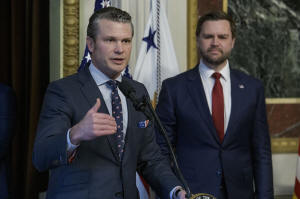As Hegseth takes charge at the Pentagon, here's what changes could be in
store
 Send a link to a friend
Send a link to a friend
 [January 27, 2025]
By LOLITA C. BALDOR and TARA COPP [January 27, 2025]
By LOLITA C. BALDOR and TARA COPP
WASHINGTON (AP) — When Defense Secretary Pete Hegseth starts his first
official day on Monday morning, he will face a daunting array of issues
to tackle — from global conflicts and border security to administrative
tasks.
At the top of his list is addressing President Donald Trump's priority
to strengthen the U.S. military presence along the southern border and
reviewing whether active-duty forces should be used for law enforcement
— something done rarely.
Dozens of other issues will compete for his attention, including
developing the Pentagon's massive budget, decisions about aid to
Ukraine, support for the ceasefire in Gaza, troop deployments in the
Middle East. Not to mention Trump directives to rid the federal
government of diversity programs and personnel as well as moves to cut
waste and remove any lingering Biden administration backers.
In a message to the force shortly after he was sworn in Saturday,
Hegseth cited the challenges he sees ahead. Some are ones his
predecessors also faced, such as reorienting the military from decades
of a Mideast focus and better deterring China. Continued conflict in the
region, including the October 2023 attack on Israel by Hamas, has made
that shift impossible to execute.
Hegseth also told service members about other priorities, including
strengthening the defense industrial base and getting the Pentagon to
pass an audit, while ensuring that the U.S. remains “the strongest and
most lethal force in the world."

He made an unannounced stop to the Pentagon on Saturday after the
swearing-in ceremony at the Eisenhower Executive Office Building. There
was no media coverage of his arrival. The Pentagon later released an
official photo saying Hegseth was “ready to get to work on behalf of
America’s warriors.”
Already, support staff have been meeting with military leaders,
including Gen. CQ Brown Jr., chairman of the Joint Chiefs of Staff. But
Hegseth will get to experience what many describe as “drinking from a
firehose” as he works to quickly get up to speed on what his 2.1 million
service members and 780,000 civilians in the department are doing. Among
them are tens of thousands serving overseas, including in combat zones.
Then there are the cultural issues that Hegseth railed on as a media
personality that did not make it into Hegseth’s message to the military.
Many expect they will surface in the coming days.
Here are some key issues that Hegseth, who was confirmed in a
tiebreaking vote Friday by Vice President JD Vance, will face right
away:
Border deployments
In trying to meet Trump's demand of securing the border, Hegseth will
face a barrage of information about what troops are available, what
assistance the Border Patrol needs and where, as well as how to house,
feed and transport the troops and border personnel and how to ensure
none of this affects other national security requirements.
One of his first big decisions is whether he will recommend that
active-duty troops deployed to the border get involved in law
enforcement, a move that military leaders in recent years have pushed to
avoid.
Active-duty forces are prohibited from doing law enforcement duties on
U.S. soil under the Posse Comitatus Act. Trump has signed an executive
order directing that his defense and homeland security secretaries
report back within 90 days on whether they think he should invoke the
1807 law called the Insurrection Act, which allows troops to be used for
civilian law enforcement on U.S. soil during emergencies.
During previous deployments, troops have been used for transportation,
intelligence, logistics, wall-building and other support tasks, freeing
up the Border Patrol to interact with migrants and conduct the law
enforcement duties.

Transgender troops
In his first executive order, Trump again stripped protections for
transgender troops that Democratic President Joe Biden had restored
after Trump banned those members from serving during his first term in
office.
The ban previously faced legal challenges, and lawyers who represented
transgender forces last time are readying to take it up in the courts
again. While Trump has not announced a ban, his decision to revoke
protections is seen as a first step toward that.
[to top of second column]
|

Pete Hegseth speaks after being sworn in as Secretary of Defense by
Vice President JD Vance in the Indian Treaty Room of the Eisenhower
Executive Office Building on the White House campus in Washington,
Saturday, Jan. 25, 2025. (AP Photo/Rod Lamkey, Jr.)

It is unclear how many troops would be affected. The Defense
Department has no exact figure on the number of transgender troops
serving because not every transgender person is in the same state of
medical transition and not every transgender person identifies as
such in military paperwork.
The department has referred queries on how many transgender troops
there are to the services; the services have said they have no way
to track.
The budget and Ukraine
Hegseth will have to become familiar with the complicated
construction of the Pentagon budget, which right now is about $850
billion. Trump ran on a vow to make the U.S. military more lethal —
something Hegseth has echoed. But they also have spoken extensively
about cutting waste.
So Hegseth's imprint on the budget will be studied to determine how
that's being done.
Woven into those discussions will be security assistance to Ukraine.
The State Department has ordered a freeze on new funding for almost
all U.S. foreign aid, and there was no indication of a waiver for
military assistance for Ukraine like there was for Israel and Egypt.
The Biden administration provided Kyiv with more than $66 billion in
military aid and weapons during the war with Russia. It had left
unspent about $3.85 billion in congressionally authorized funding to
send more weapons to Ukraine from existing U.S. stockpiles — a sum
that is not affected by the foreign aid freeze. But it is now up to
Hegseth and Trump to decide whether or not to spend it, and Trump
hasn’t said what he will do on Ukraine aid.
Diversity, equity and inclusion rollbacks
Hegseth will take over the Pentagon's push to implement Trump's
executive order to get rid of DEI programs, coming as military
officers fret over whether they will be fired for being “woke," as
Hegseth has pledged to do.
During his Senate hearing, Hegseth said DEI policies “divide” troops
and do not prioritize “meritocracy.” In post Sunday on X, Hegseth
said the department would comply immediately with Trump's order.
“Those who do not comply will no longer work here,” he wrote on
secretary of defense stationery, as seen in a photo.

Officials said the Defense Department doesn’t have any full-time
workers assigned to DEI so they don’t expect to have to fire people,
as other federal agencies have.
But senior leaders have been poring over their websites to delete
pages that mention diversity. Lacking clear guidance, staffers were
pulling websites down in often inconsistent ways. The Army, for
example, temporarily removed its sexual assault guidelines before
they later came back online.
Hegseth also has railed against women in combat in his books and on
podcasts and said standards were lowered for them, which is not
true. He has since toned down his criticism after substantial
pushback from lawmakers.
He most recently told senators that he's not aware that Trump wants
to roll back the decision to allow women to serve in all combat
jobs. Instead, he has talked about doing a review of standards.
Reproductive care
After the Supreme Court in 2022 ended constitutional protections for
abortion that were set out in Roe v. Wade, then-Defense Secretary
Lloyd Austin came out with a policy that would allow service members
to take leave and be reimbursed for travel expenses to obtain
reproductive care — including abortions and in-vitro fertilization —
if the military base they were assigned to was in a state that had
banned that care.
It’s not clear whether Hegseth will seek to further revise that
policy to remove the reimbursement provisions. It has been only
scarcely used, and the department does not break down what the
travel was for due to medical privacy laws.
All contents © copyright 2025 Associated Press. All rights reserved |